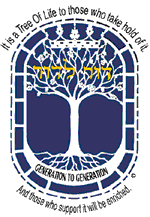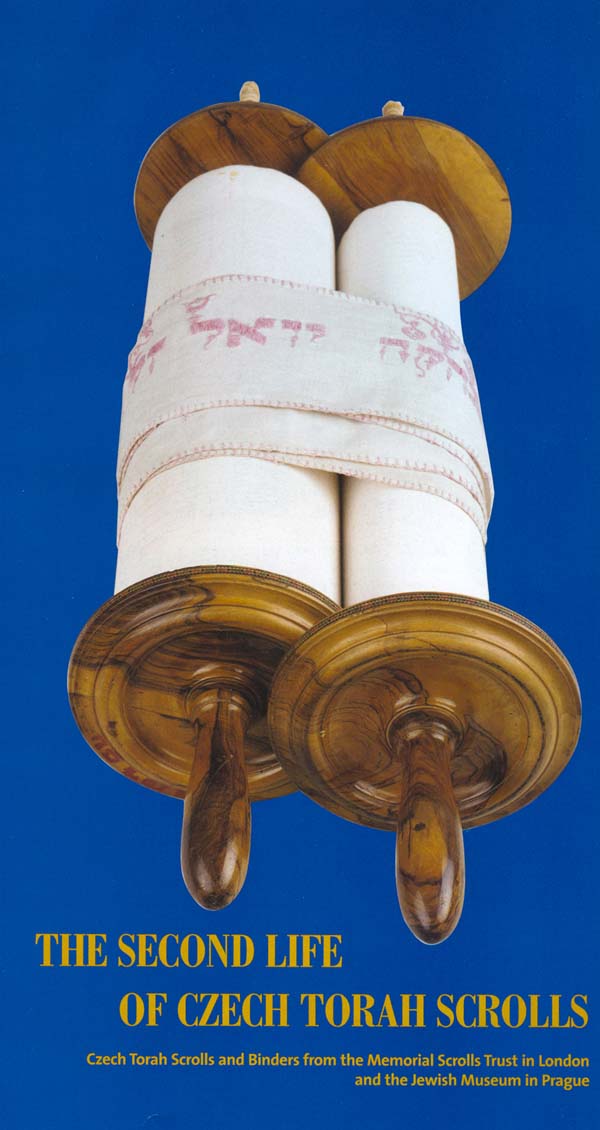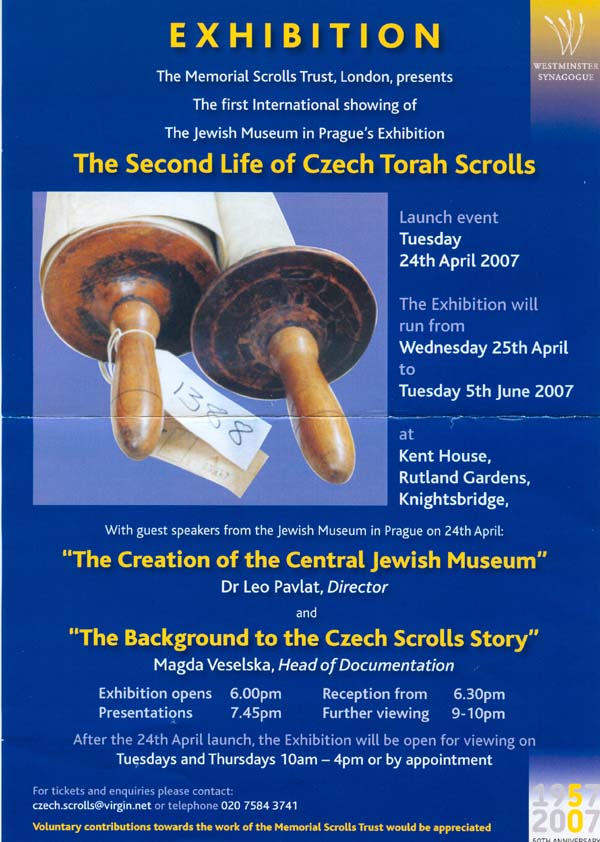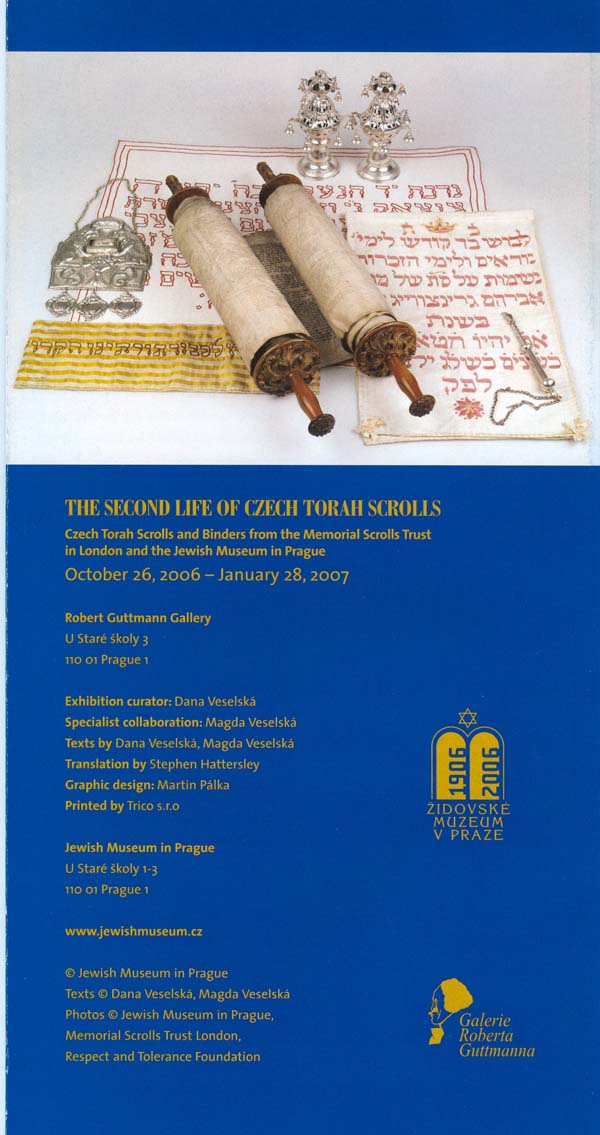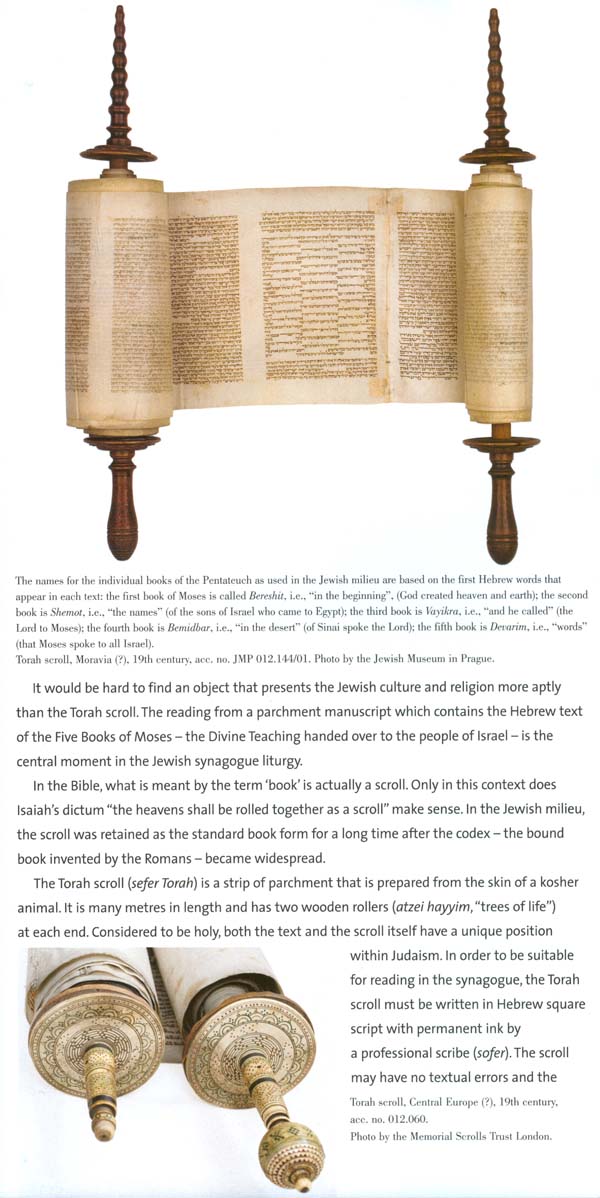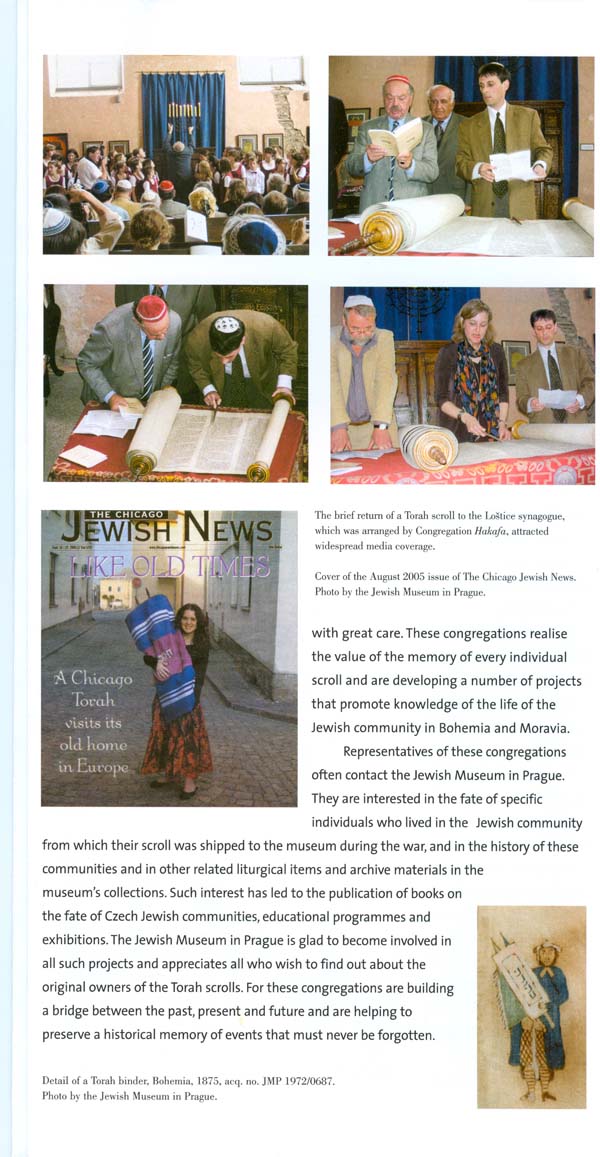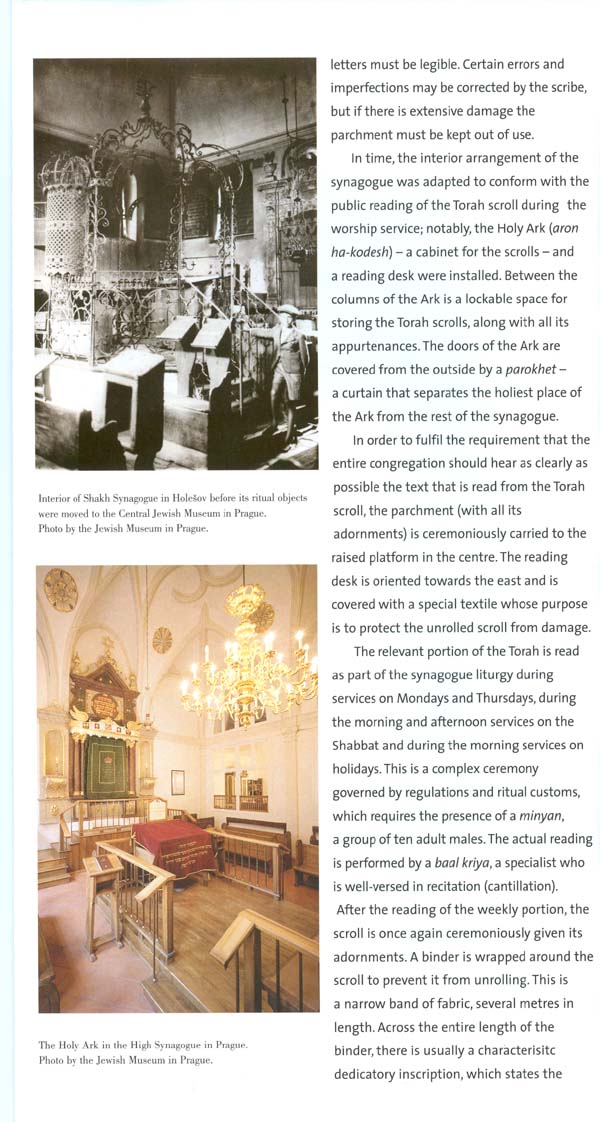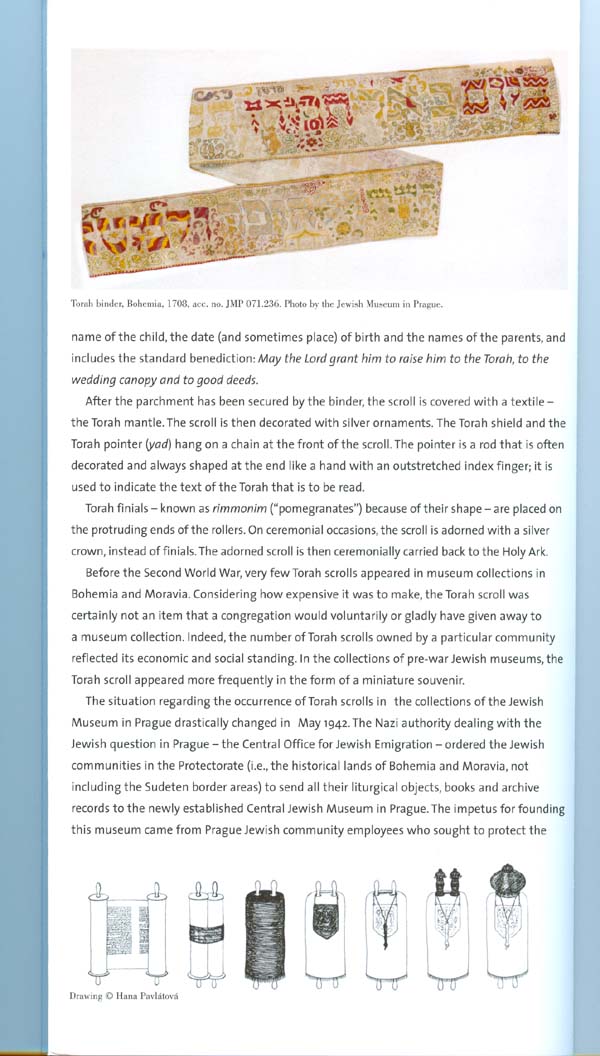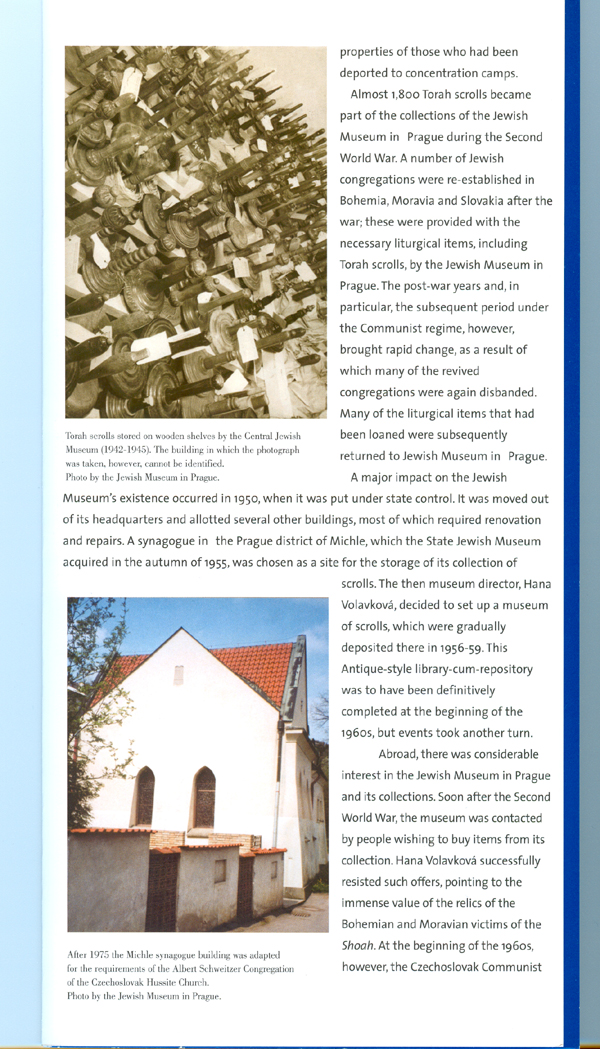|
|
The Second Life Of Czech Torah Scrolls
The Memorial Scrolls Trust of London, England recently organized the first international showing of The Jewish Museum in Prague's exhibition of The Second Life of the Czech Torah Scrolls. The Prague exhibition ran from 9-26-06 through 1-28-07 in their Guttmann Gallery. The showing in London took place at the Scrolls Trust from April 24, 2007 to June 5, 2007. Guest speakers contributed to the event who shared their experiences and knowledge of Czech Scrolls. Click on the images to the right for a closer look at the event brochure. The following review of the exhibition appears on the Zidovske Museum V Praze website (the Jewish Museum in Prague), a wonderful website dedicated to preserving the memory of Jewish life in the former Czechoslovakia. It would be hard to find an object that presents the Jewish culture and religion more aptly than the Torah scroll. The reading from a parchment manuscript which contains the Hebrew text of the Five Books of Moses – the Divine Teaching handed over to the people of Israel – is the central moment in the Jewish synagogue liturgy. The Torah scroll (sefer Torah) is a strip of parchment that is prepared from the skin of a kosher animal. It is many metres in length and has two wooden rollers (atzei hayyim, “trees of life”) at each end. Considered to be holy, both the text and the scroll itself have a unique position within Judaism. In order to be suitable for reading in the synagogue, the Torah scroll must be written in Hebrew square script with permanent ink by a professional scribe (sofer). The scroll may have no textual errors and the letters must be legible. Certain errors and imperfections may be corrected by the scribe, but if there is extensive damage the parchment must be kept out of use. In time, the interior arrangement of the synagogue was adapted to conform with the public reading of the Torah scroll during the worship service; notably, the Holy Ark (aron ha-kodesh) – a cabinet for the scrolls – and a reading desk were installed. Between the columns of the Ark is a lockable space for storing the Torah scrolls, along with all its appurtenances. The doors of the Ark are covered from the outside by a parokhet – a curtain that separates the holiest place of the Ark from the rest of the synagogue. In order to fulfil the requirement that the entire congregation should hear as clearly as possible the text that is read from the Torah scroll, the parchment (with all its adornments) is ceremoniously carried to the raised platform in the centre. The reading desk is oriented towards the east and is covered with a special textile whose purpose is to protect the unrolled scroll from damage. The relevant portion of the Torah is read as part of the synagogue liturgy during services on Mondays and Thursdays, during the morning and afternoon services on the Shabbat and during the morning services on holidays. This is a complex ceremony governed by regulations and ritual customs, which requires the presence of a minyan, a group of ten adult males. The actual reading is performed by a baal kriya, a specialist who is well-versed in recitation (cantillation). After the parchment has been secured by the binder, the scroll is covered with a textile – the Torah mantle. The scroll is then decorated with silver ornaments. The Torah shield and the Torah pointer (yad) hang on a chain at the front of the scroll. The pointer is a rod that is often decorated and always shaped at the end like a hand with an outstretched index finger; it is used to indicate the text of the Torah that is to be read. Before the Second World War, very few Torah scrolls appeared in museum collections in Bohemia and Moravia. Considering how expensive it was to make, the Torah scroll was certainly not an item that a congregation would voluntarily or gladly have given away to a museum collection. Indeed, the number of Torah scrolls owned by a particular community reflected its economic and social standing. In the collections of pre-war Jewish museums, the Torah scroll appeared more frequently in the form of a miniature souvenir. The situation regarding the occurrence of Torah scrolls in the collections of the Jewish Museum in Prague drastically changed in May 1942. The Nazi authority dealing with the Jewish question in Prague – the Central Office for Jewish Emigration – ordered the Jewish communities in the Protectorate (i.e., the historical lands of Bohemia and Moravia, not including the Sudeten border areas) to send all their liturgical objects, books and archive records to the newly established Central Jewish Museum in Prague. The impetus for founding this museum came from Prague Jewish community employees who sought to protect the properties of those who had been deported to concentration camps. Almost 1,800 Torah scrolls became part of the collections of the Jewish Museum in Prague during the Second World War. A number of Jewish congregations were re-established in Bohemia, Moravia and Slovakia after the war; these were provided with the necessary liturgical items, including Torah scrolls, by the Jewish Museum in Prague. The post-war years and, in particular, the subsequent period under the Communist regime, however, brought rapid change, as a result of which many of the revived congregations were again disbanded. Many of the liturgical items that had been loaned were subsequently returned to Jewish Museum in Prague. A major impact on the Jewish Museum’s existence occurred in 1950, when it was put under state control. It was moved out of its headquarters and allotted several other buildings, most of which required renovation and repairs. A synagogue in the Prague district of Michle, which the State Jewish Museum acquired in the autumn of 1955, was chosen as a site for the storage of its collection of scrolls. The then museum director, Hana Volavková, decided to set up a museum of scrolls, which were gradually deposited there in 1956-59. This Antique-style library-cum-repository was to have been definitively completed at the beginning of the 1960s, but events took another turn. Abroad, there was considerable interest in the Jewish Museum in Prague and its collections. Soon after the Second World War, the museum was contacted by people wishing to buy items from its collection. Hana Volavková successfully resisted such offers, pointing to the immense value of the relics of the Bohemian and Moravian victims of the Shoah. At the beginning of the 1960s, however, the Czechoslovak Communist regime undertook several initial attempts to sell liturgical items from Jewish Museum to interested parties abroad. Encouraged by its success, it then began a systematic search, via the state-owned Artia corporation, for a market for multiple copies of items in the museum’s collections. The shipment of this immense amount of important Jewish ritual items attracted great attention in London. The scrolls found refuge at Kent House, the headquarters of the recently established Jewish congregation at Westminster, of which the above mentioned philanthropist – the London lawyer and businessman Ralph Yablon – was a member. The scrolls were stored there while it was being decided how best to make use of them. Two possible options were considered: the scrolls that were in good condition or were repairable could be loaned for liturgical uses while those that were not repairable could be provided for commemorative purposes. In 1965, and for the next almost 40 years, the core of all activities relating to the care, and later distribution, of the Torah scrolls was overseen by Ruth Shaffer. The distribution of Torah scrolls entailed a number of difficulties, even though clearly defined rules had been laid down: the items were to be provided on permanent loan, not to private individuals but to congregations that were in need of them. Requests were dealt with on an individual basis and were often turned down for various reasons – as, for example, when it was suspected that the interested party had commercial designs on a Torah scroll. The vast majority of usable Torah scrolls from Bohemia and Moravia have now been distributed to Jewish congregations, Shoah memorials, museums and libraries across the world. The rest of the scrolls are part of a collection in a small museum at Kent House which commemorates the fate of the scrolls and the history of the Jews of Bohemia and Moravia. The scrolls that the Czech Memorial Scrolls Trust has loaned to congregations are being looked after with great care. These congregations realise the value of the memory of every individual scroll and are developing a number of projects that promote knowledge of the life of the Jewish community in Bohemia and Moravia. Representatives of these congregations often contact the Jewish Museum in Prague. They are interested in the fate of specific individuals who lived in the Jewish community from which their scroll was shipped to the museum during the war, and in the history of these communities and in other related liturgical items and archive materials in the museum’s collections. Such interest has led to the publication of books on the fate of Czech Jewish communities, educational programmes and exhibitions. The Jewish Museum in Prague is glad to become involved in all such projects and appreciates all who wish to find out about the original owners of the Torah scrolls. For these congregations are building a bridge between the past, present and future and are helping to preserve a historical memory of events that must never be forgotten. |

© 1999-2006, The Czech Torah Network. All Rights Reserved.
The logo design was created by Risa Mandelberg and is being used with permission.
© 1997, the paperdoll company. All Rights Reserved.
For questions or comments about this Web site please e-mail The Czech Torah Network at czechtorah@aol.com.
